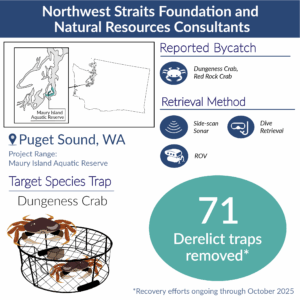 The Northwest Straits Foundation (NWSF) is a nonprofit based in Bellingham, Washington dedicated to protecting and restoring the Salish Sea by removing harmful derelict fishing gear, restoring vital marine habitats, and working with communities on shoreline stewardship. Since 2002, NWSF has worked with Natural Resources Consultants (NRC), a fisheries consulting firm that offers expertise on fisheries management, research, and collaborative solutions. Together, NWSF and NRC have removed more than 8,000 derelict crab pots and over 5,800 fishing nets.
The Northwest Straits Foundation (NWSF) is a nonprofit based in Bellingham, Washington dedicated to protecting and restoring the Salish Sea by removing harmful derelict fishing gear, restoring vital marine habitats, and working with communities on shoreline stewardship. Since 2002, NWSF has worked with Natural Resources Consultants (NRC), a fisheries consulting firm that offers expertise on fisheries management, research, and collaborative solutions. Together, NWSF and NRC have removed more than 8,000 derelict crab pots and over 5,800 fishing nets.
As a project partner of the National TRAP program, NWSF and NRC retrieve primarily recreational Dungeness crab pots from the Maury Island Aquatic Reserve. Designated in 2004, this 5,530 acre reserve is located in central Puget Sound and protects extensive eelgrass beds, mudflats, and forage fish spawning grounds. The area is popular for recreational fishing and crabbing, with more than 200,000 recreational crabbing licenses allocated each year throughout the Puget Sound region. Recreational fishing accounts for approximately 80% of trap loss. This often occurs when traps are not weighed down and shift with the currents or do not use enough trap line to account for the tides. Boat traffic also causes traps to become derelict when propellers cut their buoy lines.
Dungeness crab pots use cotton twine, or “rot” cord, designed to degrade and open the escape panel after being underwater for an extended period. Typically, these escape vents function as intended, but, on occasion, Dungeness crabs are found trapped inside. Out of 71 traps retrieved as of August 2025, only four had Dungeness crabs and 11 had other bycatch such as red rock crabs.
On trap retrieval days, crews composed of boat operators, surface-supplied air (hose) divers, and a biologist head out on the water. The crew uses side-scan sonar to locate each derelict trap, then drop a weighted line for the diver to follow to the sea floor. Sunny days are preferred, as poor underwater visibility can make it a challenge to locate the traps. Once located, the diver clips a line to the trap and the boat hauls the trap to the surface. Traps that are too deep for divers to retrieve are marked for a remotely operated vehicle (ROV) to retrieve on another day. NWSF and NRC aim to collect 25 traps per day, but have brought back 45-50 on days with clear visibility. The crew on the boat checks the trap for bycatch, evaluates the reason the pot became derelict, and assesses if the trap can be donated or reused for research. Pots that cannot be reused are sent to a nearby recycling center.
Given the scale of recreational fishing in Puget Sound and the number of lost traps (estimated at nearly 11,000 per year!), there is a need for awareness and education on proper crabbing techniques. The Northwest Straits Foundation conducts widespread educational outreach to teach the tricks of the trade and prevent unnecessary marine debris. NWSF recently developed their Catch More Crab website complete with instructional videos, workshops, and resources for recreational crabbers to have more successful catches and prevent lost traps. NWSF is also educating the residents of Vashon-Maury Island about the derelict trap issue. Informational videos about derelict gear are played on the ferries used by Island residents and visitors.